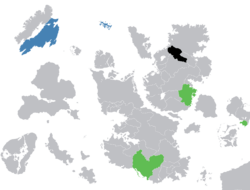Attempted annexation of the Western Tundra
| Western Tundra Crises Attempted Annexation of the Western Tundra | |||||||
|---|---|---|---|---|---|---|---|
| Part of the Western Tundra Crisis | |||||||
 | |||||||
| |||||||
| Belligerents | |||||||
|
| |||||||
| Strength | |||||||
|
Rombergian military forces
|
Aquitaynian military forces
Riysan military forces
Cassonne military forces
| ||||||
| Casualties and losses | |||||||
| 1 M.Cs 82 Illusion due to mechanical reasons | |||||||
| Part of on the |
| Tundra Crisis of 2016 |
|---|
 |
|
|
The terra nullius territory of Lorecia known as the Western Tundra was annexed by the United Realms of Romberg on 21 July, 2016. Since then, the territory has been in dispute between different nations. Romberg claims the Western Tundra is a de facto state of the United Realms, citing archeological evidence supporting the claim that the current inhabitants of the region are direct descendants of Rombergian colonists. The annexation was followed by a military intervention by Romberg in the Western Tundra to solidify their claims on the region, following crippling international sanctions due to the announcement.
On 20-21 July, 2016, Rombergian Kaiser Johann Lenesov V convened meetings with his top advisors and eventually made a televised address to the nation and the international community that Romberg would be pressing its claim on the Western Tundra. The Kaiser stated that "we, the nation, are the primary holders of the claim to the northern tundra lands of Lorecia", directly citing the archeological studies to back his claim. Due to the cultural disparities of the inhabitants of the Western Tundra, there were no large-scale demonstrations in response to the announcement - indeed, most of the inhabitants of the region didn't know a claim had been made at all. On 22 July, the Aquitaynian parliament convened in an emergency session and passed a law stating that the Prime Minister had days to draft sanctions against Romberg. These sanctions would be followed in the next few days by Riysa, Cassonne, Valkea, and East Astyrian Treaty Alliance nations with a universal EATA sanctions program spearheaded by the Blackhelm Confederacy.
Aquitayne, and jointly the Tel Al-Riyah Pact, views the annexation of the Western Tundra by Romberg to be a violation of international law and agreements by Romberg, including previously standing treaties with Glisandia over the handling of the region. Further, the Tel Al-Riyah Pact views the annexation of the Western Tundra by Romberg to be an act of imperialism, and on 25 July, announced that a blockade and No Fly Zone across the region would be enforced as soon as the necessary resources arrived in the area. This prompted a massive movement of Rombergian and Aquitaynian forces into the Western Tundra in the following weeks, leading to heightened tensions across the region and brought both nations to the brink of open war. The crash of an Aquitaynian air force jet almost prompted a pre-emptive strike on Rombergian forces in the region.
Following peace talks in Khyragus, the Treaty of Sentra was signed, in which Romberg relinquished all claims on the Western Tundra, and an international coalition was formed to develop the region and diminish the Holy Domain terrorist group activities in the region.
Background
Rombergian descendants
History
Western Tundra crisis begins
Rombergian deployment
Aquitaynian incursion into the Western Tunra
Treaty of Sentra
Subsequent events
Aftermath
Economic implications
Human rights situation
Tundran public opinion
TARP response
Cadenza, notably, dissented from an otherwise united response by the Tel Al-Riyah Pact.
Rombergian response
International response
Sanctions
Sanctions programs were approved by various nations across Astyria in the wake of Kaiser Johann Lenesov V's announcement that Romberg had laid claim to the territories. Sanctions were approved by Aquitayne, Riysa, Valkea, and East Astyrian Treaty Alliance nations, led by the Blackhelm Confederacy, and other countries and international organizations. The results of the sanctions programs has been correlated to a seizure of over $900 million NSD in Aquitaynian financial accounts, as well as a 1,337 point drop in the Rombergian Stock Exchange a day after Aquitaynian sanctions were imposed, leading to a massive sell-off of Rombergian international businesses, specifically those operating in the import/export markets. When EATA sanctions were announced, the Rombergian stock exchange dropped a further 1,892 points after recovering slightly from the Aquitaynian sanctions.
A majority of the nations who imposed sanctions against Romberg in the early days of the conflict still have their sanctions imposed against the nation. Notably, Caprica, a prominent EATA member, declined to push forward a sanctions program despite public opinion. The majority of other EATA nations, including the Dangish Empire, an economic powerhouse for the alliance, followed the Confederacy's lead in imposing harsh sanctions against the island-nation.